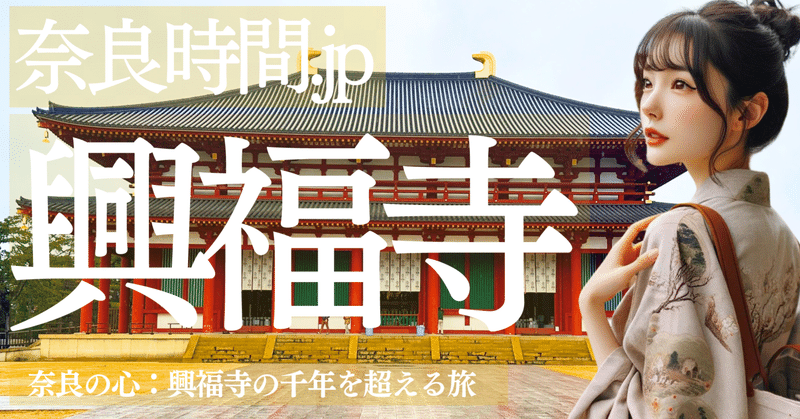
【奈良時間.jp】第2回 奈良の心:興福寺の千年を超える旅
興福寺は、その創建から現代に至るまで、日本の仏教及び文化史において中心的な役割を果たしてきた法相宗の大本山です。その起源は7世紀に遡り、藤原鎌足の妻、鏡女王によって建立された山階寺が前身とされています。この地が、後に興福寺として知られるようになる過程は、日本史における重要な転換点を反映しています。興福寺の名は、710年に平城京への遷都と共に与えられ、以来、この寺院は、奈良時代から現代に至るまで、日本の仏教及び社会の発展に深く関わってきました。

奈良時代:仏教の黎明期
奈良時代は、日本における仏教の黎明期であり、興福寺はこの時代に四大寺の一つとして認識されました。国家による保護のもと、仏教は政治的、文化的な面で重要な役割を担い、興福寺もまた、その中心的な場となりました。この時代の興福寺は、仏教教育の拠点として多くの僧侶や学者を輩出し、日本仏教の基礎を築いたと言えるでしょう。

平安時代:藤原氏との関係の深化
平安時代には、興福寺は七大寺の一つに数えられ、特に藤原氏からの厚い保護を受けました。この時代、興福寺は春日社の実権を掌握し、大和国の領主としての地位も確立。藤原氏と深い結びつきを持つことで、興福寺は政治的にも重要な役割を果たしました。また、この時代は日本仏教美術が花開いた時期でもあり、興福寺には多くの美術品が納められ、その多くが今日国宝として保存されています。

鎌倉・室町時代:武家政権下での地位の保持
鎌倉時代に入ると、興福寺は大和国の守護としての役割を果たし、武家政権下でもその地位を保ちました。室町時代には、足利将軍家との関係を深め、時の権力者との関係を通じて寺の安泰を図りました。しかし、南北朝時代の動乱など、この時代にも興福寺は多くの試練に直面しました。

明治時代:神仏分離令による試練
明治時代の神仏分離令は、興福寺にとって前例のない試練でした。多くの堂塔が破壊され、寺領も失うなど、一時期はその存続さえ危ぶまれました。しかし、この困難な時期を乗り越え、寺僧や信者の尽力により、興福寺は復興を遂げ、現代においても信仰の中心地としての役割を果たしています。

現代:文化財としての価値の再認識
現代の興福寺は、奈良の重要な文化財として、また活動的な宗教施設として、多くの人々に親しまれています。五重塔や中金堂をはじめとする建築物、阿修羅像を含む貴重な仏像群は、奈良時代からの歴史と文化の継承者として、今なお大きな価値を持ちます。興福寺を訪れることは、深い歴史的背景と豊かな文化遺産に触れることを意味し、訪問者にとっては、ただ古い寺院を訪れる以上の意味を持ちます。興福寺は、過去と現在、そして未来をつなぐ架け橋として、その存在感を放ち続けています。

興福寺の歴史は、単に時間の経過を示すものではなく、日本の仏教、文化、社会が交錯する複雑な物語を紡ぎ出しています。この寺院が持つ無形の価値は、時代を超えて受け継がれるべきものであり、現代においてもその重要性は変わりません。興福寺を訪れるすべての人にとって、その場所が提供する平和と静寂、そして深い歴史の理解は、かけがえのない体験となるでしょう。
特におすすめ建築物
《五重塔》
興福寺の五重塔は、寺のシンボルともいえる建築物で、現存する塔は1426年に再建されたものです。高さ約50メートルで、日本の木造建築物としては五重塔の中では比較的高い部類に入ります。五重塔は奈良時代に初めて建立されたとされ、その後、火災や天災で何度も焼失し、再建されてきました。塔内には四天王像が安置されていたと伝えられていますが、現在は公開されていないため、内部を見学することはできません。しかし、その壮大な姿は多くの人々を引きつけ、興福寺を訪れる者にとって見逃せない存在です。
《中金堂(金堂)》
中金堂は興福寺の本堂にあたり、寺の中心的な役割を果たしてきました。奈良時代に創建された後、何度もの災害に遭い、現在の建物は1709年に再建されたものです。中金堂には、興福寺の本尊である阿弥陀如来をはじめ、脇侍の観音菩薩と勢至菩薩の像が安置されています。これらの仏像は、日本仏教美術の傑作として高く評価されています。中金堂は、その歴史的価値と美術的価値から、多くの研究者や観光客の関心を集めています。
The Heart of Nara: Kofukuji Temple's Journey Through a Millennium
Kofukuji Temple has played a central role in the history of Buddhism and culture in Japan from its foundation to the present day. Its origins date back to the 7th century, established by the wife of Fujiwara no Kamatari, Empress Komyo, as Yamashinadera, which is considered its predecessor. The process by which this site became known as Kofukuji reflects significant turning points in Japanese history. The name Kofukuji was given in 710, coinciding with the move of the capital to Heijo-kyo, and since then, the temple has been deeply involved in the development of Buddhism and society in Japan, from the Nara period to the present day.
Nara Period: The Dawn of Buddhism
The Nara period was the dawn of Buddhism in Japan, and Kofukuji was recognized as one of the four great temples of this era. Under the protection of the state, Buddhism played an important role politically and culturally, with Kofukuji becoming a central place for this. The temple served as a hub for Buddhist education, producing many monks and scholars, and can be said to have laid the foundations for Japanese Buddhism.
Heian Period: Deepening Ties with the Fujiwara Clan
During the Heian period, Kofukuji was counted as one of the seven great temples and received considerable protection from the Fujiwara clan. The temple took control of the Kasuga Shrine and established its position as a lord of Yamato Province. By maintaining close ties with the Fujiwara clan, Kofukuji played an important political role. This period also saw the flowering of Japanese Buddhist art, with many artworks stored in Kofukuji, many of which are preserved as national treasures today.
Kamakura and Muromachi Periods: Maintaining Status Under the Military Government
Entering the Kamakura period, Kofukuji played a role as the guardian of Yamato Province and maintained its status under the military government. In the Muromachi period, the temple deepened its relationship with the Ashikaga shogunate, ensuring its security through ties with the power holders of the time. However, the temple faced many trials during this era, including the turmoil of the Nanboku-cho period.
Meiji Period: Trials of the Kami and Buddhas Separation Order
The Kami and Buddhas Separation Order of the Meiji period presented an unprecedented trial for Kofukuji, with many of its buildings destroyed and lands lost, at one point threatening its very survival. However, overcoming this difficult period with the efforts of monks and believers, Kofukuji has been revived and continues to play a role as a center of faith today.
Present Day: Re-recognition of Cultural Value
Today, Kofukuji is cherished as an important cultural asset of Nara and an active religious facility. Its architectural structures, including the five-storied pagoda and the Central Golden Hall, along with precious statues such as the Ashura statue, hold great value as inheritors of history and culture from the Nara period. Visiting Kofukuji means engaging with a deep historical background and rich cultural heritage, offering visitors more than just a visit to an old temple. Kofukuji continues to shine as a bridge connecting the past, present, and future.
The history of Kofukuji is not merely a passage of time but weaves a complex narrative where Japanese Buddhism, culture, and society intersect. The intangible value held by the temple transcends time and remains significant today. For all who visit Kofukuji, the peace, silence, and deep understanding of history it offers are invaluable experiences.
Especially Recommended Structures
The Five-Storied Pagoda
The five-storied pagoda, a symbol of the temple, was rebuilt in 1426 and stands about 50 meters tall, making it one of the taller wooden buildings in Japan. Originally established in the Nara period, it has been destroyed and rebuilt several times due to fires and natural disasters. Although the Four Heavenly Kings statues were said to be housed within, the interior is not open to the public. Nevertheless, its magnificent presence continues to attract many visitors, making it a not-to-be-missed sight for those visiting Kofukuji.
The Central Golden Hall (Kondo)
The Central Golden Hall serves as the main hall of Kofukuji, playing a central role throughout its history. Established in the Nara period and reconstructed in 1709 after several disasters, it houses the principal image of Amitabha Tathagata, flanked by statues of the Bodhisattvas Avalokiteshvara and Mahasthamaprapta. These statues are highly regarded masterpieces of Japanese Buddhist art. The Central Golden Hall draws the interest of researchers and tourists alike, due to its historical and artistic value.
この記事が気に入ったらサポートをしてみませんか?
